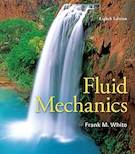Two-Phase Fluid Flow
This page provides the chapter on two-phase fluid flow from the "DOE Fundamentals Handbook: Thermodynamics, Heat Transfer, and Fluid Flow," DOE-HDBK-1012/3-92, U.S. Department of Energy, June 1992.
Other related chapters from the "DOE Fundamentals Handbook: Thermodynamics, Heat Transfer, and Fluid Flow" can be seen to the right.
Two-Phase Fluid Flow
Water at saturation conditions may exist as both a fluid and a vapor. This mixture of steam and water can cause unusual flow characteristics within fluid systems.
Two-Phase Fluid Flow
All of the fluid flow relationships discussed previously are for the flow of a single phase of fluid whether liquid or vapor. At certain important locations in fluid flow systems the simultaneous flow of liquid water and steam occurs, known as two-phase flow. These simple relationships used for analyzing single-phase flow are insufficient for analyzing two-phase flow.
There are several techniques used to predict the head loss due to fluid friction for two-phase flow. Two-phase flow friction is greater than single-phase friction for the same conduit dimensions and mass flow rate. The difference appears to be a function of the type of flow and results from increased flow speeds. Two-phase friction losses are experimentally determined by measuring pressure drops across different piping elements. The two-phase losses are generally related to single-phase losses through the same elements.
One accepted technique for determining the two-phase friction loss based on the single-phase loss involves the two-phase friction multiplier (R), which is defined as the ratio of the two-phase head loss divided by the head loss evaluated using saturated liquid properties.
where:
| R | = | two-phase friction multiplier (no units) |
| Hf , two-phase | = | two-phase head loss due to friction (ft) |
| Hf , saturated liquid | = | single-phase head loss due to friction (ft) |
The friction multiplier (R) has been found to be much higher at lower pressures than at higher pressures. The two-phase head loss can be many times greater than the single-phase head loss.
Although a wide range of names has been used for two-phase flow patterns, we shall define only three types of flow. The flow patterns to be used are defined as follows:
- Bubbly flow: there is dispersion of vapor bubbles in a continuum of liquid.
- Slug flow: in bubbly flow, the bubbles grow by coalescence and ultimately become of the same order of diameter as the tube. This generates the typical bullet-shaped bubbles that are characteristic of the slug-flow regime.
- Annular flow: the liquid is now distributed between a liquid film flowing up the wall and a dispersion of droplets flowing in the vapor core of the flow.
Flow Instability
Unstable flow can occur in the form of flow oscillations or flow reversals. Flow oscillations are variations in flow due to void formations or mechanical obstructions from design and manufacturing. A flow oscillation in one reactor coolant channel sometimes causes flow oscillations in the surrounding coolant channels due to flow redistribution. Flow oscillations are undesirable for several reasons. First, sustained flow oscillations can cause undesirable forced mechanical vibration of components. This can lead to failure of those components due to fatigue. Second, flow oscillations can cause system control problems of particular importance in liquid-cooled nuclear reactors because the coolant is also used as the moderator. Third, flow oscillations affect the local heat transfer characteristics and boiling. It has been found through testing that the critical heat flux (CHF) required for departure from nucleate boiling (DNB) can be lowered by as much as 40% when flow is oscillating. This severely reduces the thermal limit and the power density along the length of the reactor core. Again, it has been found through testing that flow oscillations are not a significant problem for some pressurized water reactors unless power is above 150% for the normal flow conditions. Flow oscillations can be a problem during natural circulation operations because of the low flow rates present.
During natural circulation, the steam bubbles formed during a flow oscillation may have enough of an effect to actually cause complete flow reversal in the affected channel.
Both the flow oscillations and flow reversals lead to a very unstable condition since the steam blankets formed on heated surfaces directly affect the ability to transfer heat away from those surfaces.
Pipe Whip
If a pipe were to rupture, the reaction force created by the high velocity fluid jet could cause the piping to displace and cause extensive damage to components, instrumentation, and equipment in the area of the rupture. This characteristic is similar to an unattended garden hose or fire hose "whipping" about unpredictably. This type of failure is analyzed to minimize damage if pipe whip were to occur in the vicinity of safety-related equipment.
Water Hammer
Water hammer is a liquid shock wave resulting from the sudden starting or stopping of flow. It is affected by the initial system pressure, the density of the fluid, the speed of sound in the fluid, the elasticity of the fluid and pipe, the change in velocity of the fluid, the diameter and thickness of the pipe, and the valve operating time.
During the closing of a valve, kinetic energy of the moving fluid is converted into potential energy. Elasticity of the fluid and pipe wall produces a wave of positive pressure back toward the fluid's source. When this wave reaches the source, the mass of fluid will be at rest, but under tremendous pressure. The compressed liquid and stretched pipe walls will now start to release the liquid in the pipe back to the source and return to the static pressure of the source. This release of energy will form another pressure wave back to the valve. When this shockwave reaches the valve, due to the momentum of the fluid, the pipe wall will begin to contract. This contraction is transmitted back to the source, which places the pressure in the piping below that of the static pressure of the source. These pressure waves will travel back and forth several times until the fluid friction dampens the alternating pressure waves to the static pressure of the source. Normally, the entire hammer process takes place in under one second.
The initial shock of suddenly stopped flow can induce transient pressure changes that exceed the static pressure. If the valve is closed slowly, the loss of kinetic energy is gradual. If it is closed quickly, the loss of kinetic energy is very rapid. A shock wave results because of this rapid loss of kinetic energy. The shock wave caused by water hammer can be of sufficient magnitude to cause physical damage to piping, equipment, and personnel. Water hammer in pipes has been known to pull pipe supports from their mounts, rupture piping, and cause pipe whip.
Pressure Spike
A pressure spike is the resulting rapid rise in pressure above static pressure caused by water hammer. The highest pressure spike attained will be at the instant the flow changed and is governed by the following equation.
$$ \Delta P = { \rho ~c ~\Delta v \over g_c } $$where:
| ΔP | = | Pressure spike (lbf/ft2) |
| ρ | = | Density of the fluid (lbm/ft3) |
| c | = | Velocity of the pressure wave (Speed of sound in the fluid) (ft/sec) |
| Δv | = | Change in velocity of the fluid (ft/sec) |
| gc | = | Gravitational constant 32.17 (lbm-ft/lbf-sec2) |
Example: Pressure spike
Water at a density of 62.4 lbm/ft3 and a pressure of 120 psi is flowing through a pipe at 10 ft/sec. The speed of sound in the water is 4780 ft/sec. A check valve suddenly closed. What is the maximum pressure of the fluid in psi?
Solution:
Steam Hammer
Steam hammer is similar to water hammer except it is for a steam system. Steam hammer is a gaseous shock wave resulting from the sudden starting or stopping of flow. Steam hammer is not as severe as water hammer for three reasons:
- The compressibility of the steam dampens the shock wave
- The speed of sound in steam is approximately one third the speed of sound in water.
- The density of steam is approximately 1600 times less than that of water.
The items of concern that deal with steam piping are thermal shock and water slugs (i.e., condensation in the steam system) as a result of improper warm up.
Operational Considerations
Water and steam hammer are not uncommon occurrences in industrial plants. Flow changes in piping systems should be done slowly as part of good operator practice. To prevent water and steam hammer, operators should ensure liquid systems are properly vented and ensure gaseous or steam systems are properly drained during start-up. When possible, initiate pump starts against a closed discharge valve, and open the discharge valve slowly to initiate system flow. If possible, start-up smaller capacity pumps before larger capacity pumps. Use warm-up valves around main stream stop valves whenever possible. If possible, close pump discharge valves before stopping pumps. Periodically verify proper function of moisture traps and air traps during operation.



